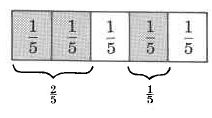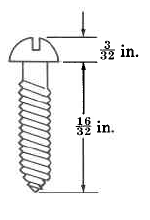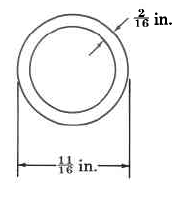5.1: Addition and Subtraction of Fractions with Like Denominators
- Page ID
- 48857
\( \newcommand{\vecs}[1]{\overset { \scriptstyle \rightharpoonup} {\mathbf{#1}} } \)
\( \newcommand{\vecd}[1]{\overset{-\!-\!\rightharpoonup}{\vphantom{a}\smash {#1}}} \)
\( \newcommand{\id}{\mathrm{id}}\) \( \newcommand{\Span}{\mathrm{span}}\)
( \newcommand{\kernel}{\mathrm{null}\,}\) \( \newcommand{\range}{\mathrm{range}\,}\)
\( \newcommand{\RealPart}{\mathrm{Re}}\) \( \newcommand{\ImaginaryPart}{\mathrm{Im}}\)
\( \newcommand{\Argument}{\mathrm{Arg}}\) \( \newcommand{\norm}[1]{\| #1 \|}\)
\( \newcommand{\inner}[2]{\langle #1, #2 \rangle}\)
\( \newcommand{\Span}{\mathrm{span}}\)
\( \newcommand{\id}{\mathrm{id}}\)
\( \newcommand{\Span}{\mathrm{span}}\)
\( \newcommand{\kernel}{\mathrm{null}\,}\)
\( \newcommand{\range}{\mathrm{range}\,}\)
\( \newcommand{\RealPart}{\mathrm{Re}}\)
\( \newcommand{\ImaginaryPart}{\mathrm{Im}}\)
\( \newcommand{\Argument}{\mathrm{Arg}}\)
\( \newcommand{\norm}[1]{\| #1 \|}\)
\( \newcommand{\inner}[2]{\langle #1, #2 \rangle}\)
\( \newcommand{\Span}{\mathrm{span}}\) \( \newcommand{\AA}{\unicode[.8,0]{x212B}}\)
\( \newcommand{\vectorA}[1]{\vec{#1}} % arrow\)
\( \newcommand{\vectorAt}[1]{\vec{\text{#1}}} % arrow\)
\( \newcommand{\vectorB}[1]{\overset { \scriptstyle \rightharpoonup} {\mathbf{#1}} } \)
\( \newcommand{\vectorC}[1]{\textbf{#1}} \)
\( \newcommand{\vectorD}[1]{\overrightarrow{#1}} \)
\( \newcommand{\vectorDt}[1]{\overrightarrow{\text{#1}}} \)
\( \newcommand{\vectE}[1]{\overset{-\!-\!\rightharpoonup}{\vphantom{a}\smash{\mathbf {#1}}}} \)
\( \newcommand{\vecs}[1]{\overset { \scriptstyle \rightharpoonup} {\mathbf{#1}} } \)
\( \newcommand{\vecd}[1]{\overset{-\!-\!\rightharpoonup}{\vphantom{a}\smash {#1}}} \)
Learning Objectives
- be able to add and subtract fractions with like denominators
Addition of Fraction With Like Denominators
Let's examine the following diagram.

2 one-fifths and 1 one fifth is shaded.
It is shown in the shaded regions of the diagram that
(2 one-fifths) + (1 one-fifth) = (3 one-fifths)
That is,
\(\dfrac{2}{5} + \dfrac{1}{5} = \dfrac{3}{5}\)
From this observation, we can suggest the following rule.
Method of Adding Fractions Having Like Denominators
To add two or more fractions that have the same denominators, add the numerators and place the resulting sum over the common denominator. Reduce, if necessary.
Sample Set A
Find the following sums.
\(\dfrac{3}{7} + \dfrac{2}{7}\). The denominators are the same. Add the numerators and place that sum over 7.
Solution
\(\dfrac{3}{7} + \dfrac{2}{7} = \dfrac{3 + 2}{7} = \dfrac{5}{7}\)
Sample Set A
\(\dfrac{1}{8} + \dfrac{3}{8}\). The denominators are the same. Add the numerators and place the sum over 8. Reduce.
Solution
\(\dfrac{1}{8} + \dfrac{3}{8} = \dfrac{1 + 3}{8} = \dfrac{4}{8} = \dfrac{1}{2}\)
Sample Set A
\(\dfrac{4}{9} + \dfrac{5}{9}\). The denominators are the same. Add the numerators and place the sum over 9.
Solution
\(\dfrac{4}{9} + \dfrac{5}{9} = \dfrac{4 + 5}{9} = \dfrac{9}{9} = 1\)
Sample Set A
\(\dfrac{7}{8} + \dfrac{5}{8}\). The denominators are the same. Add the numerators and place the sum over 8.
Solution
\(\dfrac{7}{8} + \dfrac{5}{8} = \dfrac{7 + 5}{8} = \dfrac{12}{8} = \dfrac{3}{2}\)
Sample Set A
To see what happens if we mistakenly add the denominators as well as the numerators, let's add
\(\dfrac{1}{2} + \dfrac{1}{2}\)
Adding the numerators and mistakenly adding the denominators produces
\(\dfrac{1}{2} + \dfrac{1}{2} = \dfrac{1 + 1}{2 + 2} = \dfrac{2}{4} = \dfrac{1}{2}\)
This means that two \(\dfrac{1}{2}\)'s is the same as one \(\dfrac{1}{2}\). Preposterous! We do not add denominators.
Practice Set A
Find the following sums.
\(\dfrac{1}{10} + \dfrac{3}{10}\)
- Answer
-
\(\dfrac{2}{5}\)
Practice Set A
\(\dfrac{1}{4} + \dfrac{1}{4}\)
- Answer
-
\(\dfrac{1}{2}\)
Practice Set A
\(\dfrac{7}{11} + \dfrac{4}{11}\)
- Answer
-
\(1\)
Practice Set A
\(\dfrac{3}{5} + \dfrac{1}{5}\)
- Answer
-
\(\dfrac{4}{5}\)
Practice Set A
Show why adding both the numerators and denominators is preposterous by adding \(\dfrac{3}{4}\) and \(\dfrac{3}{4}\) and examining the result.
- Answer
-
\(\dfrac{3}{4} + \dfrac{3}{4} = \dfrac{3 + 3}{4 + 4} = \dfrac{6}{8} = \dfrac{3}{4}\), so two \(\dfrac{3}{4}\)'s = one \(\dfrac{3}{4}\), whihch is preposterous.
Subtraction of Fractions With Like Denominators
We can picture the concept of subtraction of fractions in much the same way we pictured addition.

From this observation, we can suggest the following rule for subtracting fractions having like denominators:
Subtraction of Fractions with Like Denominators
To subtract two fractions that have like denominators, subtract the numerators and place the resulting difference over the common denominator. Reduce, if possible.
Sample Set B
Find the following differences.
\(\dfrac{3}{5} - \dfrac{1}{5}\). The denominators are the same. Subtract the numerators. Place the difference over 5.
Solution
\(\dfrac{3}{5} - \dfrac{1}{5} = \dfrac{3 - 1}{5} = \dfrac{2}{5}\)
Sample Set B
\(\dfrac{8}{6} - \dfrac{2}{6}\). The denominators are the same. Subtract the numerators. Place the difference over 6.
Solution
\(\dfrac{8}{6} - \dfrac{2}{6} = \dfrac{8 - 2}{6} = \dfrac{6}{6} = 1\)
Sample Set B
\(\dfrac{16}{9} - \dfrac{2}{9}\). The denominators are the same. Subtract numerators and place the difference over 9.
Solution
\(\dfrac{16}{9} - \dfrac{2}{9} = \dfrac{16 - 2}{9} = \dfrac{14}{9}\)
Sample Set B
To see what happens if we mistakenly subtract the denominators, let's consider
\(\dfrac{7}{15} - \dfrac{4}{15} = \dfrac{7 - 4}{15 - 15} = \dfrac{3}{0}\)
We get division by zero, which is undefined. We do not subtract denominators.
Practice Set B
Find the following differences.
\(\dfrac{10}{13} - \dfrac{8}{13}\)
- Answer
-
\(\dfrac{2}{13}\)
Practice Set B
\(\dfrac{5}{12} - \dfrac{1}{12}\)
- Answer
-
\(\dfrac{1}{3}\)
Practice Set B
\(\dfrac{1}{2} - \dfrac{1}{2}\)
- Answer
-
0
Practice Set B
\(\dfrac{26}{10} - \dfrac{14}{10}\)
- Answer
-
\(\dfrac{6}{5}\)
Practice Set B
Show why subtracting both the numerators and the denominators is in error by performing the subtraction \(\dfrac{5}{9} - \dfrac{2}{9}\)
- Answer
-
\(\dfrac{5}{9} - \dfrac{2}{9} = \dfrac{5 - 2}{9 - 9} = \dfrac{3}{0}\), which is undefined
Exercises
For the following problems, find the sums and differences. Be sure to reduce.
Exercise \(\PageIndex{1}\)
\(\dfrac{3}{8} + \dfrac{2}{8}\)
- Answer
-
\(\dfrac{5}{8}\)
Exercise \(\PageIndex{2}\)
\(\dfrac{1}{6} + \dfrac{2}{6}\)
Exercise \(\PageIndex{3}\)
\(\dfrac{9}{10} + \dfrac{1}{10}\)
- Answer
-
1
Exercise \(\PageIndex{4}\)
\(\dfrac{3}{11} + \dfrac{4}{11}\)
Exercise \(\PageIndex{5}\)
\(\dfrac{9}{15} + \dfrac{4}{15}\)
- Answer
-
\(\dfrac{13}{15}\)
Exercise \(\PageIndex{6}\)
\(\dfrac{3}{10} + \dfrac{2}{10}\)
Exercise \(\PageIndex{7}\)
\(\dfrac{5}{12} + \dfrac{7}{12}\)
- Answer
-
1
Exercise \(\PageIndex{8}\)
\(\dfrac{11}{16} - \dfrac{2}{16}\)
Exercise \(\PageIndex{9}\)
\(\dfrac{3}{16} - \dfrac{3}{16}\)
- Answer
-
0
Exercise \(\PageIndex{10}\)
\(\dfrac{15}{23} - \dfrac{2}{23}\)
Exercise \(\PageIndex{11}\)
\(\dfrac{1}{6} - \dfrac{1}{6}\)
- Answer
-
0
Exercise \(\PageIndex{12}\)
\(\dfrac{1}{4} + \dfrac{1}{4} + \dfrac{1}{4}\)
Exercise \(\PageIndex{13}\)
\(\dfrac{3}{11} + \dfrac{1}{11} + \dfrac{5}{11}\)
- Answer
-
\(\dfrac{9}{11}\)
Exercise \(\PageIndex{14}\)
\(\dfrac{16}{20} + \dfrac{1}{20} + \dfrac{2}{20}\)
Exercise \(\PageIndex{15}\)
\(\dfrac{12}{8} + \dfrac{2}{8} - \dfrac{1}{8}\)
- Answer
-
\(\dfrac{1}{2}\)
Exercise \(\PageIndex{16}\)
\(\dfrac{11}{16} + \dfrac{9}{16} - \dfrac{5}{16}\)
Exercise \(\PageIndex{17}\)
\(\dfrac{4}{20} - \dfrac{1}{20} + \dfrac{9}{20}\)
- Answer
-
\(\dfrac{3}{5}\)
Exercise \(\PageIndex{18}\)
\(\dfrac{7}{10} - \dfrac{3}{10} + \dfrac{11}{10}\)
Exercise \(\PageIndex{19}\)
\(\dfrac{16}{5} - \dfrac{1}{5} - \dfrac{2}{5}\)
- Answer
-
\(\dfrac{13}{5}\)
Exercise \(\PageIndex{20}\)
\(\dfrac{21}{35} - \dfrac{17}{35} + \dfrac{31}{35}\)
Exercise \(\PageIndex{21}\)
\(\dfrac{5}{2} + \dfrac{16}{2} - \dfrac{1}{2}\)
- Answer
-
10
Exercise \(\PageIndex{22}\)
\(\dfrac{1}{18} + \dfrac{3}{18} + \dfrac{1}{18} + \dfrac{4}{18} - \dfrac{5}{18}\)
Exercise \(\PageIndex{23}\)
\(\dfrac{6}{22} - \dfrac{2}{22} + \dfrac{4}{22} - \dfrac{1}{22} + \dfrac{11}{22}\)
- Answer
-
\(\dfrac{9}{11}\)
The following rule for addition and subtraction of two fractions is preposterous. Show why by performing the operations using the rule for the following two problems.
Preposterous Rule
To add or subtract two fractions, simply add or subtract the numerators and place this result over the sum or difference of the denominators.
Exercise \(\PageIndex{24}\)
\(\dfrac{3}{10} - \dfrac{3}{10}\)
Exercise \(\PageIndex{25}\)
\(\dfrac{8}{15} + \dfrac{8}{15}\)
- Answer
-
\(\dfrac{16}{30} = \dfrac{8}{15}\) (using the preposterous rule)
Exercise \(\PageIndex{26}\)
Find the total length of the screw.

Two months ago, a woman paid off \(\dfrac{3}{24}\) of a loan. One month ago, she paid off \(\dfrac{5}{24}\) of the total loan. This month she will again pay off \(\dfrac{5}{24}\) of the total loan. At the end of the month, how much of her total loan will she have paid off?
- Answer
-
\(\dfrac{13}{24}\)
Exercise \(\PageIndex{27}\)
Find the inside diameter of the pipe.

Exercises for Review
Exercise \(\PageIndex{28}\)
Round 2,650 to the nearest hundred.
- Answer
-
2700
Exercise \(\PageIndex{29}\)
Use the numbers 2, 4, and 8 to illustrate the associative property of addition.
Exercise \(\PageIndex{30}\)
Find the prime factors of 495.
- Answer
-
\(3^2 \cdot 5 \cdot 11\)
Exercise \(\PageIndex{31}\)
Find the value of \(\dfrac{3}{4} \cdot \dfrac{16}{25} \cdot \dfrac{5}{9}\).
Exercise \(\PageIndex{32}\)
\(\dfrac{8}{3}\) of what number is \(1 \dfrac{7}{9}\)?
- Answer
-
\(\dfrac{2}{3}\)


